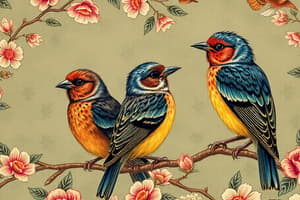Podcast
Questions and Answers
What is the primary food source of finches?
What is the primary food source of finches?
- Arthropods and berries
- Insects and worms
- Nuts and seeds (correct)
- Fruits and vegetables
Which of the following is NOT a member of the finch family?
Which of the following is NOT a member of the finch family?
- Siskins
- Canaries
- Redpolls
- Penguins (correct)
What is the worldwide distribution of true finches?
What is the worldwide distribution of true finches?
- They are found only in Australia and the polar regions
- They are found only in the tropical regions
- They are found only in the northern hemisphere
- They are found everywhere in the world except Australia and the polar regions (correct)
What is the largest species of true finch?
What is the largest species of true finch?
What is the smallest species of true finch?
What is the smallest species of true finch?
What is the primary use of finches and canaries in the coal mining industry?
What is the primary use of finches and canaries in the coal mining industry?
How many subfamilies is the family Fringillidae divided into?
How many subfamilies is the family Fringillidae divided into?
What is the primary diet of euphoniines?
What is the primary diet of euphoniines?
Why has the taxonomy of the finch family been complicated?
Why has the taxonomy of the finch family been complicated?
Flashcards
What do finches eat?
What do finches eat?
Nuts and seeds are the primary food source for finches.
Are Penguins finches?
Are Penguins finches?
Penguins are not finches. They belong to a different bird family.
Where are finches found?
Where are finches found?
Finches are found worldwide, with the exception of Australia and the polar regions.
Who's the biggest finch?
Who's the biggest finch?
Signup and view all the flashcards
Who's the smallest finch?
Who's the smallest finch?
Signup and view all the flashcards
Why are finches used in mining?
Why are finches used in mining?
Signup and view all the flashcards
How many subfamilies are there in the finch family?
How many subfamilies are there in the finch family?
Signup and view all the flashcards
What does the Euphoniines subfamily eat?
What does the Euphoniines subfamily eat?
Signup and view all the flashcards
What makes the finch family taxonomy complex?
What makes the finch family taxonomy complex?
Signup and view all the flashcards
Study Notes
Family of Birds: Finches
- True finches are small to medium-sized passerine birds with stout conical bills adapted for eating seeds and nuts and often have colourful plumage.
- They have a worldwide distribution except for Australia and the polar regions and occupy a great range of habitats where they are usually resident and do not migrate.
- The family Fringillidae contains more than two hundred species divided into fifty genera. It includes species known as Canaries, siskins, redpolls, serins, grosbeaks and euphonias.
- Many birds in other families are also commonly called "finches", including the Darwin's finches of the Galapagos islands, now considered members of the tanager family.
- Finches and canaries were used in the UK, US and Canada in the coal mining industry to detect carbon monoxide from the eighteenth to twentieth century.
- The taxonomy of the finch family, in particular the cardueline finches, has a long and complicated history.
- The study of the relationship between the taxa has been confounded by the recurrence of similar morphologies due to the convergence of species occupying similar niches.
- The family Fringillidae is divided into three subfamilies, the Fringillinae containing a single genus with the chaffinches, the Carduelinae containing 183 species divided into 49 genera, and the Euphoniinae containing the Euphonia and the Chlorophonia.
- Fossil remains of true finches are rare, and those that are known can mostly be assigned to extant genera at least.
- The smallest "classical" true finches are the Andean siskin and the lesser goldfinch. The largest species is probably the collared grosbeak, although larger lengths and weights have been recorded in slightly smaller species.
- Finches are primarily granivorous, but euphoniines include considerable amounts of arthropods and berries in their diet.
- The family Fringillidae contains 231 species divided into 50 genera and three subfamilies.
Studying That Suits You
Use AI to generate personalized quizzes and flashcards to suit your learning preferences.




